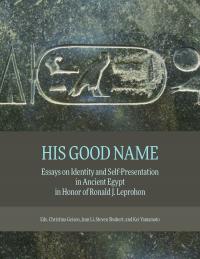His Good Name: Essays on Identity and Self-Presentation in Ancient Egypt in Honor of Ronald J. Leprohon
Synopsis
The wish to affiliate with a specific cultural, social, or ethnical group is as important today as it was in past societies, such as that of the ancient Egyptians. The same significance applies to the self-presentation of an individual within such a group. Although it is inevitable that we perceive ancient cultures through the lens of our time, place, and value systems, we can certainly try to look beyond these limitations. Questions of how the ancient Egyptians saw themselves and how individuals tried to establish and thus present themselves in society are central pieces of the puzzle of how we interpret this ancient culture. This volume focuses on the topic of identity and self-presentation, tackling the subject from many different angles: the ways in which social and personal identities are constructed and maintained; the manipulations of culture by individuals to reflect real or aspirational identities; and the methods modern scholars use to attempt to say something about ancient persons. Building on the work of Ronald J. Leprohon, to whom this volume is dedicated, contributions in this volume present an overview of our current state of understanding of patterns of identity and self-presentation in ancient Egypt. The contributions approach various aspects of identity and self-presentation through studies of gender, literature, material culture, mythology, names, and officialdom.
Chapters
-
Table of Contents
-
Panehsy’s Afterlife and the Underworld of TT 16
-
Once Again on ShetaytA Reappraisal of the “Mysterious One” in the New Kingdom Netherworld Books
-
On Being Generous as Only a Woman Can BeOn Mutirdis’s Choice of Epithets
-
Masculinities and the Mechanisms of Hegemony in the Instruction of Ptahhotep
-
His BelovedElite Women in Middle Kingdom Tombs
-
Identity and Burial Practices in the Nécropole des Chanteuses at Abydos
-
Life Cycle, Third Gendering, and Identity in Nubian A-Group Figurines
-
Who Tells the Story?Objective Narration versus Subjective Discourse in Egyptian Narrative Literature
-
The Prophecy of NefertiDystopian Literature and Ancient Egyptian Cultural and Social Identity
-
“And Many Men of the Land Rob Them as Well, and Are (Our) Companions”The Deir el-Medina Gang and the Involvement of Wider Society in Late New Kingdom Tomb Robbery
-
An Honored Boss
-
Bak, Servant of AtenAn Embodied Statement of Faith
-
Monuments of Memory at a Middle Kingdom Harbor on the Red Sea
-
A Glimpse into the Life of a Late Middle Kingdom Business ManThe Possessions of the Unknown Owner of Ramesseum Tomb No. 5
-
The Place of SilenceMusings on a Partial Ptolemaic Burial Shroud Recently Rediscovered in the Royal Ontario Museum
-
Was Viceroy Huy and Taemwadjsy at Jebel Barkal?
-
Nonroyal Participation and Self-Presentation in New Kingdom Provincial Cults
-
Concerning the Identity of Niankhnisut, His Rediscovered Tomb Chapel, the Affliated Decorative Program, and Other oughts
-
Treasurer Senwosretankh, Favored of Amenemhat III
-
Calendar of the AnimalsAnimal Observation and Management as a Marker of Time in Everyday Life
-
Fishing and Fowling for Pleasure versus ProduceAncient Egyptian Representations of Social Status in Relation to Animals and the Natural Environment
-
What’s in a Name?Iconoclasm and Damaged Inscriptions on Egyptian Sculpture
-
The Cartouche Names of Ramesses IV in the Great Hypostyle Hall of KarnakA Case of Royal Identity, Legitimation, and Historical Memory
-
Exterior Inscriptions in the Pyramid Complex of Senwosret III at Dahshur and Other Temples of the Old and Middle Kingdoms
-
Seen in TranslationConcepts of Hellenistic Kingship in the Egyptian Ptolemaic Royal Titulary
-
Indexes


